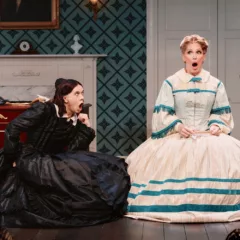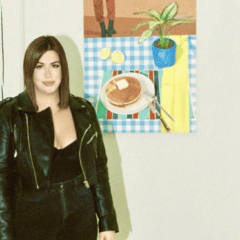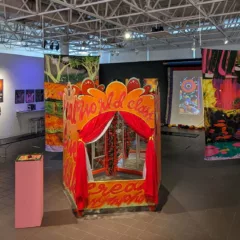(Leah Koontz and Mellisa Robbins attended the Citywide Panel at Moore College of Art and Design on Nov. 13 together. Koontz and Robbins, senior fine art students at Moore, present a distillation of a lively discussion they had about the panel, which had them talking for hours.–the Artblog editors)
The Citywide festival, this November and December, involves a group of independent Philadelphia art collectives engaged in an exchange of exhibitions, ideas, and practices. This initiative intends to unify the various neighborhood art spaces involved. On Wednesday, November 13th, Moore College of Art and Design hosted a conversation about Citywide. The participants on the panel were Matthew Higgs, Nicola Trezzi, Salem Collo-Julin and Kaytie Johnson. Richard Torchia moderated the conversation. One of the main topics discussed was artist-run spaces. These spaces are often created out of a need for an alternative within the art community. Currently we are seeing artists wear many hats and dabble in a multitude of fields. Citywide prompted many galleries to collaborate with one another. The various speakers had a range of ideas regarding this.
The role of the artist and defining the audience
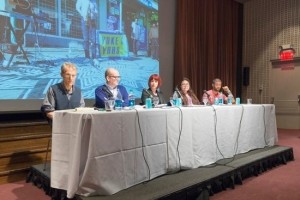
Mellisa: As a young artist myself, about to enter the Philadelphia arts community, the discussion raised a number of troubling questions for me. The first topic addressed in the panel was the importance of the artist. As a talk on artists who contribute to other fields beyond art, the participants tried to explain what artists offer society that others cannot. I immediately wondered what would happen if this question were asked in a room that was not full of artists. I cannot help but feel like artists today, at least in our area, are becoming far too self-important. I’ve sat through too many lectures and discussions like this one where artists congratulate themselves on their uniqueness and contributions to society to feel like we really are that special.
Leah: One of the big themes in the conversation was the intended audience for art. It seems to me that Matthew Higgs’ ideal audience is unapologetically made up of similar artists and friends. He stated that he is not interested in the general public, and he does not need their money. While I agree that the artist is valuable and inevitably challenges social norms, I also think it is important to view things from many standpoints in order to help everyone grow. We should want to hear the voices of the diverse community surrounding us. The artist-centric view would privilege the perspective of the artist. However, Salem Collo-Julin felt slightly differently about the question of audience. Collo-Julin feels that having an audience of many different people from various places is very important. She wants to give others a platform to offer their opinions through art. Collo-Julin explained that this is the best way to find what the crucial issues that need to be addressed really are. Art can definitely be a catalyst for social change and a great tool for addressing problems.
The very big art world – from auction houses to community art centers
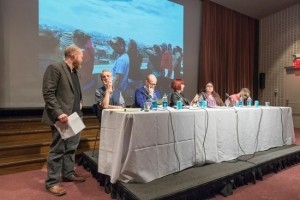
Mellisa: Matthew Higgs pointed out during the panel that we are living in the most corporate art world of all time, citing the sale of Francis Bacon’s triptych for $142 million last week. It struck me as bizarre that what we refer to as “the art world,” the thing we are all supposedly a part of, has become this removed from the average artist that might participate in something like Citywide. Where do arbitrary amounts like this come from, and what does this say about the value of art? Have you ever come across an object you felt was worth $142 million? Where is the society of old white men that decides what is worth looking at in the end?
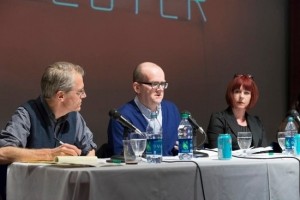
Leah: Artists are naturally inclined to crave education in many areas. Perhaps this is why artists are generally very versatile. Matthew Higgs feels that artists bring a great contribution to each field that they enter outside of traditional art. For example, he stated that artist-writers are often the most interesting because they bring a high level of creativity and use an unconventional approach.Contemporary art can do this across media but sometimes artists have a shallow understanding of the other fields in which they are working.
Artists are egotistical and assume they are the experts. I think this often unintentionally undermines the concept of the work. Filtering ideas through art or expanding the definition of the artist can be an easier platform to discuss social issues. This is especially useful through collaboration, which asks the individual to place value on the multiple or collective. I would have loved to hear more from Salem Collo-Julin and Kaytie Johnson, who made excellent points, but unfortunately they did not have as much room to speak.
Some reservations about the festival and an affirmation

Mellisa: The Citywide panel brought up my own reservations about Citywide itself. On one hand, it is an exciting event with a lot of possibility. However, I find it strange that the Philadelphia art community, already a microcosm, is so divided into small factions. In order for the whole community to interact, we’ve come up with an annual event that insists we do it. I suppose this comes back to my worries about artists in general, and the selfishness that can result from being one. We surround ourselves with those most like us in a community that is already made of artists. Perhaps this draws from elitism, or a fear of difficult criticism.
Lean and Mellisa: Ultimately we felt that the Citywide panel was valuable as a catalyst for discussion. It brought up topics that we will continue to discuss and debate. Our hope is that the Philadelphia art community will continue to offer widespread support while raising the criticality and standard of public discussion. Citywide is doing an excellent thing and we hope to see the positive interaction that comes from it continue beyond a yearly event.
A list of Citywide events can be found here. Photos courtesy of Jamie Alvarez.
Leah Koontz is a senior at Moore College of Art and Design. She is a Fine Art major with a minor in Curatorial studies. More information about her work can be found at www.leahkoontz.com.
Mellisa Robbins is expecting her BFA in Fine Arts from Moore College of Art & Design in 2014. Her work currently explores ideas of romantic ruin, lost utopias, and growing up with the promises of earnest rock songs. More information can be found at her website, www.mellisarobbins.com.


